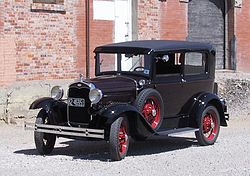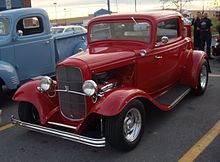Ford Model A
 |
| Manufacturer | Ford Motor Company |
|---|
| Production | 1928–1931
4,849,340 made |
|---|
| Assembly | Detroit, Michigan
Windsor, Canada
Buenos Aires, Argentina
Cologne, Germany
Copenhagen, Denmark
Cork, Ireland
Trafford Park, England
Geelong, Australia
Saint Paul, Minnesota |
|---|
| Predecessor | Ford Model T |
|---|
| Successor | Ford Model B |
|---|
| Class | Full-size Ford |
|---|
| Body style |
A – Chassis
Convertible Sedan (A-400)
Business Coupe
Coupe
Deluxe Coupe
Sport CoupeStandard Coupe
Deluxe Coupe
Standard Fordor Sedan - Murray
Standard Fordor Sedan - Briggs
Deluxe Fordor Sedan - Murray
Deluxe Fordor Sedan - BriggsLeatherback Fordor Sedan
Standard Fordor Sedan – Slant windshield
Mail Truck
Panel Truck
Phaeton 2-door
Phaeton 4-door
Deluxe Service Pickup
Roadster Pickup
Pickup
Deluxe Pickup
Standard Roadster
Deluxe Roadster
Sport Roadster
Station Wagon
Taxi Cab
Town Car
Town Car Delivery
Standard Tudor Sedan
Deluxe Tudor Sedan
Victoria
Wood Panel Delivery
Station wagon |
|---|
| Layout | FR layout |
|---|
| Platform | A Chassis |
|---|
| Engine | 201 CID (3.3 L) L-head-4 I4 |
|---|
| Transmission | 3-speed sliding gear manual |
|---|
| Wheelbase | 103.5 in (2,629 mm) |
|---|
| Length | 165 in (4,191 mm) |
|---|
| Width | 67 in (1,702 mm) |
|---|
| Curb weight | 2,265 lb (1,027 kg) |
|---|
| Related | Ford Model AF
Ford Model AA |
|---|
The Ford Model A of 1928–1931 (also colloquially called the A-Model Ford or theA, and A-bone among rodders and customizers) was the second huge success for the Ford Motor Company, after its predecessor, the Model T. First produced on October 20, 1927, but not sold until December 2, it replaced the venerable Model T, which had been produced for 18 years. This new Model A (a previous model had used the name in 1903–1904) was designated as a 1928 model and was available in four standard colors, but not black.
By 4 February 1929, one million Model As had been sold, and by 24 July, two million.The range of body styles ran from the Tudor at US$500 (in grey, green, or black) to the Town Car with a dual cowl at US$1200. In March 1930, Model A sales hit three million, and there were nine body styles available.
The Model A was produced through 1931. When production ended in March, 1932, there were 4,849,340 Model As made in all styles. Its successor was the Model B, which featured an updated 4-cylinder engine, followed by the Model 18 which introduced Ford's new flathead (sidevalve) V8 engine.
Features
Prices for the Model A ranged from US$385 for a roadster to $1400 for the top-of-the-line Town Car. The engine was a water-cooled L-head 4-cylinder with a displacement of 201 cu in (3.3 l). This engine provided 40 hp (30 kW; 41 PS). Typical fuel consumption was between 25 and 30 mpg (U.S.) (8 to 12 kilometres per litre or 8-9 l/100 km) using a Zenith one-barrel up-draft carburetor, with a top speed of around 65 mph (105 km/h); It had a 103.5 in (2,630 mm) wheelbase with a final drive ratio of 3.77:1. The transmission was a conventional 3-speed sliding gear manual unsynchronised unit with a single speed reverse. The Model A had 4-wheel mechanical drum brakes. The 1930 and 1931 editions came with stainless steel radiator cowling and headlamp housings.
The Model A came in a wide variety of styles: Coupe (Standard and Deluxe), Business Coupe, Sport Coupe, Roadster Coupe (Standard and Deluxe), Convertible Cabriolet, Convertible Sedan, Phaeton (Standard and Deluxe), Tudor Sedan (Standard and Deluxe), Town Car, Fordor (2-window) (Standard and Deluxe), Fordor (3-window) (Standard and Deluxe), Victoria, Station Wagon, Taxicab, Truck, and Commercial.
The Model A was the first Ford to use the standard set of driver controls with conventional clutch and brake pedals; throttle and gearshift. Previous Ford models used controls that had become uncommon to drivers of other makes. The Model A's fuel tank was located in the cowl, between the engine compartment's fire wall and the dash panel. It had a visual fuel gauge, and the fuel flowed to the carburetor by gravity. A rear view mirror was optional.In cooler climates, owners could purchase an aftermarket cast iron unit to place over the exhaust manifold to provide heat to the cab. A small door provided adjustment of the amount of hot air entering the cab. Model A was the first car to have safety glass in the windshield.
The Soviet company GAZ, which started as a cooperation between Ford and the Soviet Union, made a licensed version of the Model A from 1932-1936.This itself was the basis for the FAI and BA-20 armored car, which saw use as scout vehicles in the early stages of World War II.
In addition to the United States, Ford made the Model A in plants in Argentina,Canada, France, Germany and the United Kingdom.
In Europe, where cars were taxed according to engine size, Ford equipped the Ford Model A with a 2,033 cc (124.1 cu in) engine providing a claimed output of just 40 hp (30 kW; 41 PS). However, the engine size was still large enough to equate to a fiscal horsepower of 14.9 hp (11.1 kW) (as opposed to the 24 hp (18 kW) of the larger engine) and attracted a punitive annual car tax levy of £24 in the UK and similar penalties in other principal European markets. It therefore was expensive to own and too heavy and thirsty to achieve volume sales, and so unable to compete in the newly developing mass market, while also too crude to compete as a luxury product. European manufactured Model As failed to achieve the sales success in Europe that would greet their smaller successor in England and Germany.
Historical context of Model A development
In the teens and early twenties, Ford Motor Company dominated the automotive marketplace with its Model T. However, during the mid-twenties, this market dominance quickly eroded as competitors such as General Motors caught up with Ford's mass production system and began to outcompete Ford in some ways, especially by offering more choices such as more power, new convenience features, or cosmetic customization.
Ford's sales force recognized this threat as it was developing and advised Henry Ford to respond to it, but he resisted. However, features he had seen as needless, such as electric starters (for just one example), were gradually shifting in the public's perception from unneeded luxuries to minimum requirements. The sagging market share of Model T finally forced him to admit the automotive market wanted a new Ford model. When he finally agreed to begin development of this new model, he dove into the effort with a strong focus on the mechanical aspects (and on what today is called design for manufacturability (DFM), which he had always strongly embraced and for which the Model T production system was famous). The development, although ultimately successful, had plenty of bumps along the road. For example, the die stamping of parts from sheet steel, which the Ford company had led to new heights of development with the Model T production system, was something Henry had always been ambivalent about; it had brought success, but he felt that it was not the best choice for durability. He was determined that the new model (to become the Model A) would rely more on drop forgings than the T. He had ideas about improving the DFM of forging (to use today's terminology), but they did not prove practical. Ford's engineers eventually had to persuade him to relent, lest the Model A's production cost make its retail price too expensive.
Henry's disdain for cosmetic vanity as applied to automobiles led him to leave the design of Model A's body work to a team led by Edsel Ford, his son.
It was during the period of the mid-1920s to early 1930s that the limits of the first generation of mass production, epitomized by the Model T production system, became apparent. The era of "flexible mass production" had begun.
Film and media
The Ford Model A was well represented in media of the era since it was one of the most common cars. In modern times, it has reappeared, most notably in the remake of the film King Kong as taxi cabs and police cars. Students asked to build models of cars from the 1920s and 1930s will also find that models of these cars are still available from hobby shops in the 2000s, as stock cars or modified hot rods.
Perhaps in reference to the remarkable upgrade from the previous Model T, a song was written about the Model A by Irving Kaufman called Henry's Made a Lady Out Of Lizzie, a reference to the moniker Tin Lizzie given to the Model T.
Model A's were used in The Waltons television series.
Several Model A's have obtained particular notoriety. The Ramblin' Wreck, a 1930 Sport Coupe, is the official mascot of the student body at the Georgia Institute of Technology and appears at sporting events and student body functions. Ala Kart, a customized 1929 roadster pickup built by George Barris won two straight "America's Most Beautiful Roadster" awards at the Oakland Roadster Show before making numerous film and television appearances. Between October 1992 to December 1994, Hector Quevedo, along with his son Hugo, drove a 1928 Model A 22,000 miles (35,000 km) from his home in Punta Arenas, Chile to the Ford Motor Company headquarters in Dearborn, Michigan. The car required minimal service including a flat tire and transmission work in Nicaragua and is now housed in the Henry Ford Museum.
Charlie Ryan's Hot Rod Lincoln was a Model A with a Lincoln flathead V12 and other modifications.
Gallery
1928 Model A Business Coupe
1930 or 1931 Deluxe Roadster
1928 Model A engine with modern aftermarket air filter
1929 Model AA heavy-duty truck variant of the Model A
1928 Model A open-cab (roadster) pickup
-
1928 Model A hot rod with roll pan, chopped top, and late-model headlights and mirrors
A custom with 1931 Roadster body and chassis,chrome-hatted carburetors, drilled I-beam dropped front axle, finned drum brakes, and zoomie pipes
1928 Model A Ford on display at the Henry Ford Museum. Driven 22,000 miles from Chile to the museum in Dearborn, Michigan. The journey started Oct 1992 and ended Dec 1994.




























![Validate my RSS feed [Valid RSS]](valid-rss-rogers.png)














































































